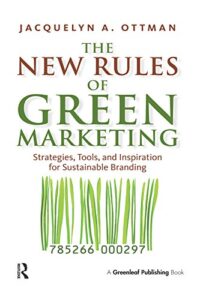I took the last month to read through The New Rules of Green Marketing by Jacquelyn A. Ottman of J. Ottman Consulting and I thought this read offered wonderful think pieces. Though published in 2011, there are takeaways that can supplement current marketing practices and campaigns to ensure they make the intended impact on consumers. I am curious what a second edition could look like at the height of internet use, fame, and trends. Nevertheless, from her expertise, Ottman displays wonderful examples of green marketing practices that make a mark and offers advice to steer one away from a potential advertising disaster.

Photo of the cover of the book ‘The New Rules of Green Marketing’.
If you’ve read any of my other postings, you know that I absolutely must start off with the tidbits that startled me. Now, I’m not a coffee drinker, I will admit that coffee does smell good, but that’s as much appreciation as I’ll give to a liquid that is essentially warm bean juice. The New Rules… covers Starbucks’ regenerative practices and I learned that almost 53 gallons of water go into the making of a single latte (190). From growth the final product– that’s ASTOUNDING. I know that Earth’s resources are plenty, but how haven’t we completely depleted everything in sight? Anyway, I was also surprised to learn that buildings tend to emit more greenhouse gases than cars (180). That still holds true today, but it’s not as if the percentages are at a staggering difference. So, as I’m sitting in my idle car in the midst of traffic and watching a semi blow off a puff of black smoke as traffic starts to move again, I can cringe a little less at the hole we’re collectively carving into the ozone layer. Ottman’s writing has allowed me to realize that we have definitely cut back on the destruction we could be doing to the Earth, but we still need to do more. Now that we have gotten that out of the way, let’s get started!
Let’s discuss
Ottman’s book widened my perspective to believe that providing ‘greener’ products for consumers, and therefore green marketing, is and should be more than just that. For example, over the years Starbucks has made efforts to cut down on its impact by offering 10 cents off drinks made in reusable cups, providing paper sleeves to offset the double cupping phenomenon, and more recently cutting down on straw usage by changing the way their cups look and therefore function. These are all wonderful innovations, but what I appreciate even more is how Starbucks is taking it a step further and investing in the communities they source their coffee and materials from. They are building on their C.A.F.E. (Coffee and Farmer Equity) practices to ensure more farmers are earning a livable wage for their crops. Years ago, Starbucks also flew 10,000 partners to New Orleans after Hurricane Katrina hit to contribute 50,000 volunteer hours to the community. Their practices may not be perfect, but I can appreciate self-awareness and movement in a better direction to contribute both socially and environmentally to our ecosystem.
I touched on it briefly, but it is somewhat satisfying to learn of the ‘greener’ practices we make now versus what was initially taking place. One example was the Starbucks paper sleeve, but another is how we’ve been phasing out older lightbulbs that are inefficient and swapping them out for LED bulbs that are better for the planet as well as our wallets. I was intrigued to learn that when the Phillips brand first introduced its most efficient lightbulb to the market, it wasn’t necessarily flying off shelves. What they did in response was lobby to have a bill passed to phase out older lightbulbs to help the planet, though still a self-serving effort it worked, and we now use more bulbs that last longer, cut down on electricity bills, and impact the planet less (176). Over time, consumers have grown wary of the chemicals and ingredients used in the products we use. As transparency grows and information is more accessible, consumers have been holding large corporations accountable by boycotting certain products and calling for cleaner and safer ingredients. One example of this changing the scene is how in 2009, Clorox pledged to no longer use bleach and sodium hydroxide to make their bleach (125). Steps like these spread amongst other retailers because they fear being left in the dust.
After reading this book, I wonder what a second edition could look like. Since the writing’s publishing in 2011, we’ve only increased our internet usage and apps that feed into people’s shortening attention time span like Twitter, Instagram, and TikTok have gone mainstream. An issue marketers are facing is how to get their message across effectively in under six seconds. Then there is the topic of virality; going viral for the right reasons can significantly boost reach, knowledge, and sales for a company. One example of this is how the language learning app Duolingo features their mascot, Duo, on their TikTok platform participating in dance trends and so forth. But going viral for the wrong reasons can leave a big, red ‘canceled’ stamp across your brand. They weren’t ‘canceled’ necessarily, but at one point, Duolingo did have to issue an apology video addressing what they did wrong and showing to their consumers that they’d learned from their past mistake and plan to do better moving forward. This phenomenon isn’t too far off from the past where instead of tweeting, companies issued press releases to brief the public on their shortcomings. While going viral isn’t the goal for most marketing plans, it’s important to have some kind of social media presence in order to stay current and make your brand more accessible to consumers with questions or feedback. Ottman’s advice for traditional marketing does translate well over into social media marketing, but I do wonder what could look different in an updated book release.
All that to say…
The New Rules… teaches us early on that providing a ‘greener’ product for consumers won’t necessarily sway them into purchasing your product, but it does make it more likely that they’ll make the leap. Green products started off as the undesirable alternative; from lightbulbs that cast an eerie, green light to detergents that leave clothes feeling a bit stiff. We’re coming off of a history of when regenerative products weren’t preferable, and now when they perform better but cost a premium, we face a new problem of affordability and a different version of convenience. The marketing of ‘greener’ products must be strategic; compare the new and improved version of a product to the previous version, provide ingredient lists, and take feedback from consumers are just some of the pieces of advice offered. Companies’ values will differ, but they can all take page from this book to learn about effective green marketing and still apply it to today’s ever changing market. This was a very miniscule commentary on the book, to read Ottman’s actual words I suggest that you pick up a copy and see what she has to say for yourself. If you’ve made it this far, thank you for taking the time out of your day to read through this.
